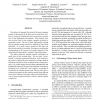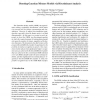MM
2005
ACM
14 years 8 months ago
2005
ACM
As one of the important research areas of multimodal interaction, sign language recognition (SLR) has attracted increasing interest. In SLR, especially on medium or large vocabula...
ICCV
2005
IEEE
14 years 8 months ago
2005
IEEE
We advocate the use of Scaled Gaussian Process Latent Variable Models (SGPLVM) to learn prior models of 3D human pose for 3D people tracking. The SGPLVM simultaneously optimizes a...
ACSC
2005
IEEE
14 years 8 months ago
2005
IEEE
Most current network intrusion detection systems employ signature-based methods or data mining-based methods which rely on labelled training data. This training data is typically ...
ISWC
2006
IEEE
14 years 9 months ago
2006
IEEE
Activity Recognition has gained a lot of interest in recent years due to its potential and usefulness for context-aware wearable computing. However, most approaches for activity r...
GECCO
2007
Springer
14 years 9 months ago
2007
Springer
In previous work [7] a computational framework was demonstrated that employs evolutionary algorithms to automatically model a given system. This is accomplished by alternating the...
ICIP
2007
IEEE
14 years 9 months ago
2007
IEEE
In this paper, we propose a learning-based demosaicing and a restoration error detection. A Vector Quantization (VQ)based method is utilized for learning. We take advantage of a s...
DASFAA
2007
IEEE
14 years 9 months ago
2007
IEEE
Nowadays many data mining/analysis applications use the graph analysis techniques for decision making. Many of these techniques are based on the importance of relationships among t...
SP
2008
IEEE
14 years 9 months ago
2008
IEEE
The efficacy of Anomaly Detection (AD) sensors depends heavily on the quality of the data used to train them. Artificial or contrived training data may not provide a realistic v...
ICTAI
2008
IEEE
14 years 9 months ago
2008
IEEE
We present a new ensemble learning method that employs a set of regional classifiers, each of which learns to handle a subset of the training data. We split the training data and ...
ICPR
2008
IEEE
14 years 9 months ago
2008
IEEE
The Gaussian mixture model (GMM) can approximate arbitrary probability distributions, which makes it a powerful tool for feature representation and classification. However, it su...



